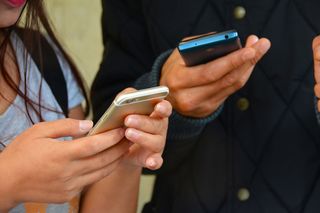Media
What Happens When In-Person Socializing Meets Smartphones?
Research examines how social multi-tasking affects mood and social connection.
Posted October 11, 2018

Smartphones are everywhere — 77% of Americans own a smartphone, and when it comes to those under 30, 94% have one. In fact, about 25% of American adults report that they are online "almost constantly" and 69% use at least some form of social media. With social media and text messaging readily available on our smartphones, most Americans are walking around with a social life in their pocket.
On the one hand, this could be good for you. Psychologists have long known that social connections contribute to psychological well-being. Most people believe that mobile phones have had a positive impact on their social relationships and they often report that staying connected with others is an important reason why they use social media. So the ability to be constantly connected could be a boon for our sense of happiness and feeling of connection. Research suggests that overall, the effects of social media on well-being are mixed.
But what about combining smartphone use with face-to-face interactions? A nationally representative survey found that 89% of respondents admitted to having used their cell phone during their most recent social interaction. However, this survey also showed that people are much more likely to say that they use their cell phones during social interactions as a way to enhance the interaction (e.g., posting a picture of the present social gathering on social media, looking up information on the Internet that is relevant to the conversation) than as a way to avoid it (e.g., because they're not interested in the in-person interaction or want to connect with someone who isn't part of that group).
On the other hand, people tend to be pretty bad at multitasking, and there is evidence that cell phones are a distraction from face-to-face interactions. Research has shown that people who believe their romantic partners are distracted by their cell phones tend to be less satisfied with their relationships. Sherry Turkle, an MIT professor who has been studying online social interactions since the 1990s, has identified what she calls "the rule of three" based on her interviews with college students. The rule is that if there are five or six people sitting together at dinner, you have to check that at least three other people are paying attention to the person who's speaking, and if so, it's considered OK for you to check out of the conversation and look at your phone. But she reports that the effect of this rule is that conversations tend to stay superficial and light. In fact, some research has shown that just having a cell phone in the room, even if you're not using it, makes conversations feel less intimate.
In one recent study, researchers investigated how using cell phones during actual face-to-face interactions throughout the day related to how satisfying those interactions were. They tested two competing possibilities:
- When it comes to social interaction, the more the better. Having additional social connections via text messages or social media might add to your in-person social interaction and make you feel even more socially connected.
- Text or social media interactions are a distraction and they interfere with how satisfying an in-person interaction feels.
In their study, the researchers asked 174 college students to report on their social interactions several times a day, over the course of a week. Five random times each day, the students would receive a text message notification to complete a brief survey. First, they rated how close they felt to others and their overall mood at the moment. Then they checked off which social interactions they had engaged in during the past 15 minutes, including face-to-face and various remote social activities, like checking social media or texting. The researchers used this information to classify each social interaction as face-to-face only, remote only, or mixed (using remote communication during a face-to-face interaction).
They found that people generally felt worse and less socially connected when they were juggling a face-to-face interaction with a remote interaction than if they were only interacting face-to-face. However, multi-tasking interactions tended to be more enjoyable than those that were remote only. The researchers did not distinguish between remote interactions that were connected to the face-to-face interaction, such as sharing a photo of the interaction on social media, and those that involved escape from the interaction. Had they done so, the effects they found might have been stronger.
This research provides further evidence that digital and face-to-face social interactions don't mix. However, when we think about this type of research, we should bear in mind the old statistics class lesson: Correlation does not imply causation. Just because people feel less connected and are in a worse mood when they're socially multi-tasking doesn't necessarily mean that the multi-tasking is harming the face-to-face interaction. There is the possibility of the reverse — that we're more likely to check our cell phones during face-to-face interactions that are boring or unsatisfying in the first place.
Most likely, both of these explanations are true. If an interaction isn't very interesting or important you may be more likely to glance at your phone in the middle of it. It's also probably the case that pulling out your phone during a face-to-face interaction diminishes your engagement with it. So the next time you get together with friends or family, it's probably a good idea to resist the temptation to pull out your smartphone.


